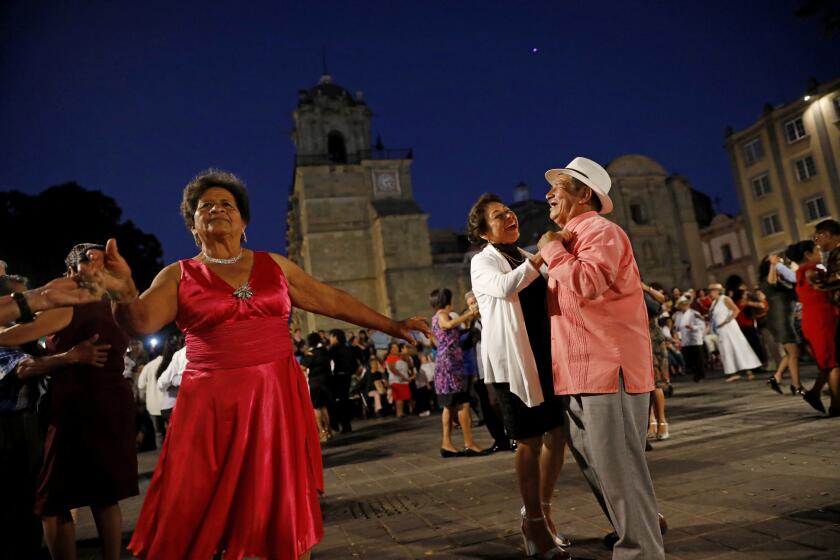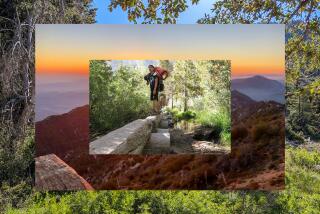This Baja island adventure was too easy. Then things got a little too real

ISLA ESPÍRITU SANTO, Mexico — I’d just snorkeled into a sea cave. Before I could see much of anything, a sea lion pup burst in front of me and nuzzled my hand with a whiskered snout. It tickled. Then came another pup, and another, all eager to play.
Well, I thought, that didn’t take long. It had been barely six hours since our panga started puttering toward the Baja desert island of Espíritu Santo, and the standout moment was already at hand. It seemed too easy.
And then the weather changed, night fell and the shouting began.
Archipiélago Espíritu Santo is one of Mexico’s youngest national parks, and Isla Espíritu Santo, surrounded by the turquoise waters of the Gulf of California, is its marquee attraction.
There are no roads, no bridges, no permanent human population. Apart from a few rangers and anglers, the only people who sleep ashore are guests and staff of a handful of eco-campgrounds that have won government permits in recent years.
On a peninsula where development hums more loudly every day, that makes the island an outlier in every sense, and I wanted a look.
The island, about 31 square miles, sits 18 miles north of La Paz. The high ground is close to 2,000 feet above sea level, and the slopes are studded with tall cardon cactuses — island cousins of the mainland’s saguaros.
Turkey vultures perch on the cactuses while pelicans and cormorants glide overhead. Meanwhile, the waters seethe with creatures that divers and snorkelers prize. Moorish idols. Parrotfish, Mexican goatfish. Sardines by the score. Moray eels. Sea turtles.
I didn’t see manta rays, hammerhead sharks or whale sharks this time, but people often do.
Saved from destruction
Things could have worked out differently on the island if developers had had their way in the 1990s. The island would now be home to at least one casino hotel and probably dozens of homes. The property lines were drawn, and the plan was in motion.
Up stepped Timothy Means, a former Colorado River guide who founded Baja Expeditions in 1974. He spent years exploring the peninsula, then rallied Californians from both sides of the border to block development of the island.
Means and local activists persuaded Mexican business leaders and American nonprofits — including the Nature Conservancy, the World Wildlife Fund and the David & Lucile Packard Foundation — to buy out the island’s private owners, give the land to the Mexican government and set aside money to help pay for its management.
UNESCO declared the area a biosphere reserve in 1995. In 2007, Mexico sealed the deal by protecting the island, its sidekick Isla Partida and the surrounding archipelago as a national park.
Means died in August. With his legacy in mind, I had signed up for a three-day, two-night island trip in October, Baja Expeditions’ first of the 2019-20 season. By luck of the draw, it would include just three guests along with guide Eric Ramírez, who has a degree in marine biology; a boat captain; a cook and two helpers.
Park officials estimate 40,000 people visited the island last year, most of them day-trippers who spent just a few hours.
Most overnight outfitters operate from fall through spring, avoiding the hottest and stormiest months of the year, charging $175 to $350 per person per night.
Oaxaca would wrap itself around my life for years to come.
Like many visitors, we headed straight for Los Islotes, a set of islets north of Isla Partida, where snorkelers and divers can swim beside a sea lion colony.
The water was busy with boats and snorkelers. But soon their numbers dwindled under the afternoon’s increasingly gray skies, and we had the luxury of hanging around.
A spell and then a storm
That’s when I had my sea lion encounter and an eye-opening spell of snorkeling, which took me within arm’s reach of at least a dozen fish species.
Through that evening and the following day, we snorkeled, kayaked and puttered on the beach, living the way Robinson Crusoe would have if he’d had the foresight to bring a cook, captain and naturalist guide.
Our tents had been pitched on Candelero Bay well before our arrival on Espíritu Santo. Each was about 10 feet square with one or two cots.
We did have to beware of jejenes — a.k.a. sand fleas — and now and then a faint chorus of pop music would seep from a yacht on the bay.
But we had better things to think about: The dawdling heron at the north end of our beach. The stony islet that stood in the bay, as tall and intricate as a Gothic church.
We snacked. We cracked beers. We hiked along the edge of the estuary, through the cactuses and red volcanic boulders above the bay, until we passed a tall, blank wall and came to a buzzing nest of wasps, face high and uninterested in us.
We perched on a boulder and listened to Ramírez talk about the Pericú, a people who lived on the island thousands of years ago and left funerary caves, rock art and fish hooks made of sea shells. Then we tiptoed back to camp, where dinner was cooking and a slight drizzle was stippling the sea.
As darkness fell, our panga captain, Juan “Tito” Lucero Cuevas, told me how he’d spent 43 of his 57 years on and around the island.
“The hardest thing is when strong winds come from the north,” he said in Spanish.
But there was no place else he’d rather be. When death comes, Lucero told me, “I hope my family and friends will put my ashes in these waters.”
Then he stepped out of the dinner tent and looked with alarm at the estuary. Lucero had heard water and realized it wasn’t the sea. It was the rain, now in torrents, gathered and channeled by the island’s ridges and arroyos, roaring toward lower ground. Toward us.
Trouble in the night
I was still in the tent when the estuary burst its banks. Water rushed past my feet, cutting a route through our camp to the beach.
The crew stripped to their bathing suits and headlamps, hollering and dashing back and forth to move equipment, food, tables, the refrigerator.
The runoff quickened and deepened. Within moments, our shade tarp had collapsed, and most of the crew’s tents were swamped. Lucero’s tent, crumpled and nudged by the current, looked as if it might join our anchored pangas offshore.
The crew had turned off our electrical hub — half a dozen car batteries, solar collectors, radios, phone chargers. But in precious little time, the water advanced within a foot of the tent that held it all.
They told me later they had been setting up camp in the same spot for 30 years and never been flooded like this. While the other guests sheltered in their tent at the untroubled north end of our beach camp, the crew grimly splashed and scrambled at the south end, where the water was rising.
I stood on the rain-pelted sand, directing my headlamp beam to help the crew see what they were doing.
The Mexican village of San Blas on the Pacific Coast is filled with history. Good food and surfing abound.
I eventually busied myself dragging kayaks to higher ground and digging a trench in hopes of channeling the runoff — a futile effort, but something to do.
And then, no more than 30 minutes after the water burst upon us, the runoff settled on a single route to the sea. It had bisected our camp, and the wind and rain raged on. There would be hours of reconstruction and clean-up ahead, but the water had stopped tearing away sections of beach.
The crew could take a breath, reclaim gear from the shallows (including Lucero’s tent and my backpack) and set up on higher ground. I walked to my tent at the north end of camp and crashed. Ramirez, tent-less, worked another few hours, then accepted my invitation to sleep on my floor.
If you make a winter trip to Isla Espíritu Santo and the same thing happens to you, I will eat my snorkel. Historically, the area gets barely 8 inches of rain per year, most of it in August and September, a bit in the first days of October. That night in mid-October was an anomaly in a place that’s usually dry.
But it was also a reminder: As long as nature is in charge, there’s plenty of risk on this island.
A rainbow and a transformed trail
Our camp was a sight in the morning. Downed tarp. Tilted rack of stand-up paddleboards. Broken mirror over the main sink. Nine inches of water in each panga. But the team was fast reassembling things.
By 8 a.m., breakfast was on a table. Sleeping bags were hanging out to dry, and the radio was crackling with plans for reinforcements. The first blue skies of the weekend appeared, along with a modest rainbow.
So we went kayaking. And bird-watching in Bahia San Gabriel.
But before we fired up the pangas and left Isla Espíritu Santo for good, we rehiked the trail to the boulders, this time skirting the runoff’s new path.
The rocks were redder, the rain-scrubbed cactus greener. The wasps had flown or drowned. And the tall, blank, red-rock wall that was so prominent? Now it was a backdrop to a roaring waterfall.
The island was new again, and except for the bug bites, I felt that way too.
If you go
THE BEST WAY TO ISLA ESPIRITU SANTO, MEXICO
From LAX, Delta, Alaska, American and Southwest offer nonstop service to Los Cabos International Airport (at San José del Cabo), and American, United, Delta, Southwest and Alaska offer connecting service (change of planes). Restricted round-trip airfare from $305, including taxes and fees. It’s about 120 miles from Los Cabos International airport to La Paz.
The following tour operators offer eco-camping with equipment, tent, meals, guide and panga transport included in daily rates. Some also offer day trips.
Baja Expeditions, 585 Calle Sonora, La Paz; (800) 843-6967 or (858) 581-3311. Offers island camping trips October through April. $205-270 per person per night.
Todos Santos Eco Adventures, 88 Calle Guaycura, Cerro la Poza, Todos Santos; (619) 446-6827 or 011-52-612-145-0189. Runs Camp Cecil de la Isla, an ecologically oriented glamping site open November through mid-June. Most trips are three days, two nights. Camp Cecil tents feature beds and elevated floors. Cost is $375 per adult per night, $275 for children ages 4 to 12. Price includes hotel transfers, boat ride, all meals and activities, gear rental, guide and national park fee.
Mar y Aventuras, 564 Topete Interior, La Paz; (406) 522-7596 or (800) 355-7140. Offers several longer Baja itineraries, including one with four nights on Espíritu Santo. From $150 per person per night.
Sea Kayak Adventures, 104 Rio Nilo, San Antonio Zacatal, La Paz; (800) 616-1943. Offers kayak-based trips to Espíritu Santo and other Gulf of California destinations. Adult rates about $200 per person per night.
Eco Migrations, 774 Álvaro Obregón, La Paz; 011-52-612-124-6755. Offers weeklong diving trips (including two hotel nights and four island camping nights) for about $285 per person per night.
Baja Camp, andrea@bajacamp.com. Offers tours June through September, unlike the others. Cost is about $275 per person per night, $170 for children 7-12.
More to Read
Sign up for The Wild
We’ll help you find the best places to hike, bike and run, as well as the perfect silent spots for meditation and yoga.
You may occasionally receive promotional content from the Los Angeles Times.








